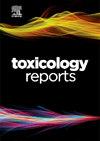Vitamin D supplementation: Biochemical and inflammatory effects in non-pathological Wistar rats
Q1 Environmental Science
引用次数: 0
Abstract
Vitamin D3 (VD3) is shown to be a biochemical and physiological modulator of the body. Debates about route of administration, prescribed dosage and serum levels have arisen, and thus the interaction of VD3 with the body in overdose. Using an experimental model of Wistar rats of both sexes, rats were subdivided into 5 groups, which represents a control group, and 4 groups with VD3 treatments (2.500, 7.000, 14.000 and 21.000 IU/kg/week) for one month. Thereafter biochemical, hormonal, inflammatory and histological analyses were performed. Regarding the biochemical findings, there was an increase in the levels of the AST in comparison of the control group with the treatments with higher doses (14.000 IU and 21.000 IU). Furthermore, changes in the inflammatory cytokine profile were identified at doses of 14,000 IU and 21,000 IU, with an increase in inflammatory cytokines (IL-1β, IL-6, IL-8 and TNF-α) and a decrease in the anti-inflammatory IL-10. Histological evaluation of the liver tissue also revealed changes at the highest doses. Finally, in the evaluation of a murine physiological model, it showed that the supplementation of VD3 in overdoses there was an inflammatory exacerbation in the body, suggesting that the VD3 supplementation should be administered with caution, and takes into account physiological factors of the individual.
补充维生素D:对非病理性Wistar大鼠的生化和炎症影响。
维生素D3 (VD3)被证明是身体的生化和生理调节剂。关于给药途径、处方剂量和血清水平的争论已经出现,因此过量时VD3与身体的相互作用。采用Wistar雌雄大鼠实验模型,将大鼠分为5组,分别为对照组和4组,分别给予VD3(2500、7000、14000、21.000 IU/kg/周)治疗1个月。随后进行生化、激素、炎症和组织学分析。关于生化结果,与对照组相比,高剂量治疗组(14000 IU和21000 IU)的AST水平有所增加。此外,在14,000 IU和21,000 IU剂量下,炎症细胞因子谱发生了变化,炎症细胞因子(IL-1β, IL-6, IL-8和TNF-α)增加,抗炎IL-10减少。肝组织的组织学评估也显示了在最高剂量下的变化。最后,在小鼠生理模型的评估中显示,过量补充VD3会导致体内炎症加剧,提示补充VD3应谨慎使用,并考虑个体的生理因素。
本文章由计算机程序翻译,如有差异,请以英文原文为准。
求助全文
约1分钟内获得全文
求助全文
来源期刊

Toxicology Reports
Environmental Science-Health, Toxicology and Mutagenesis
CiteScore
7.60
自引率
0.00%
发文量
228
审稿时长
11 weeks
 求助内容:
求助内容: 应助结果提醒方式:
应助结果提醒方式:


